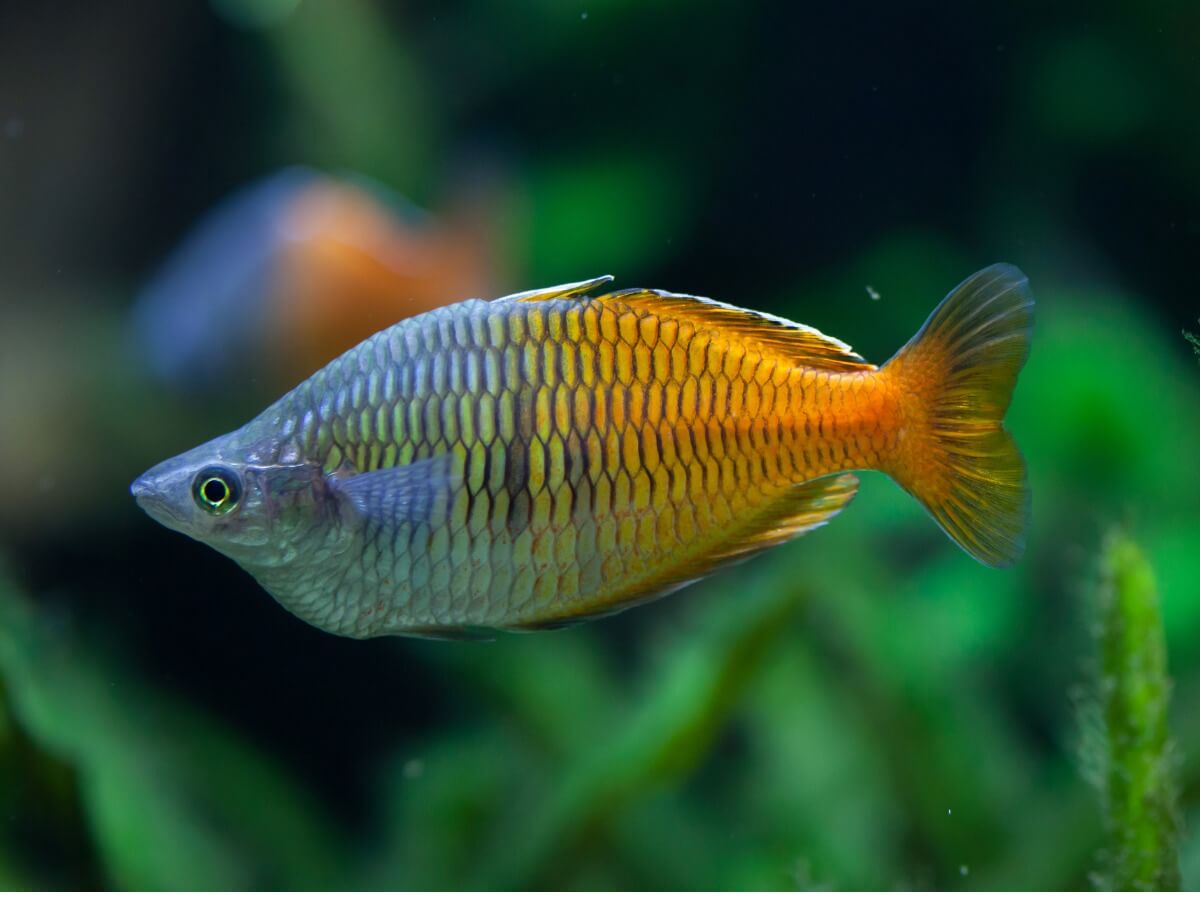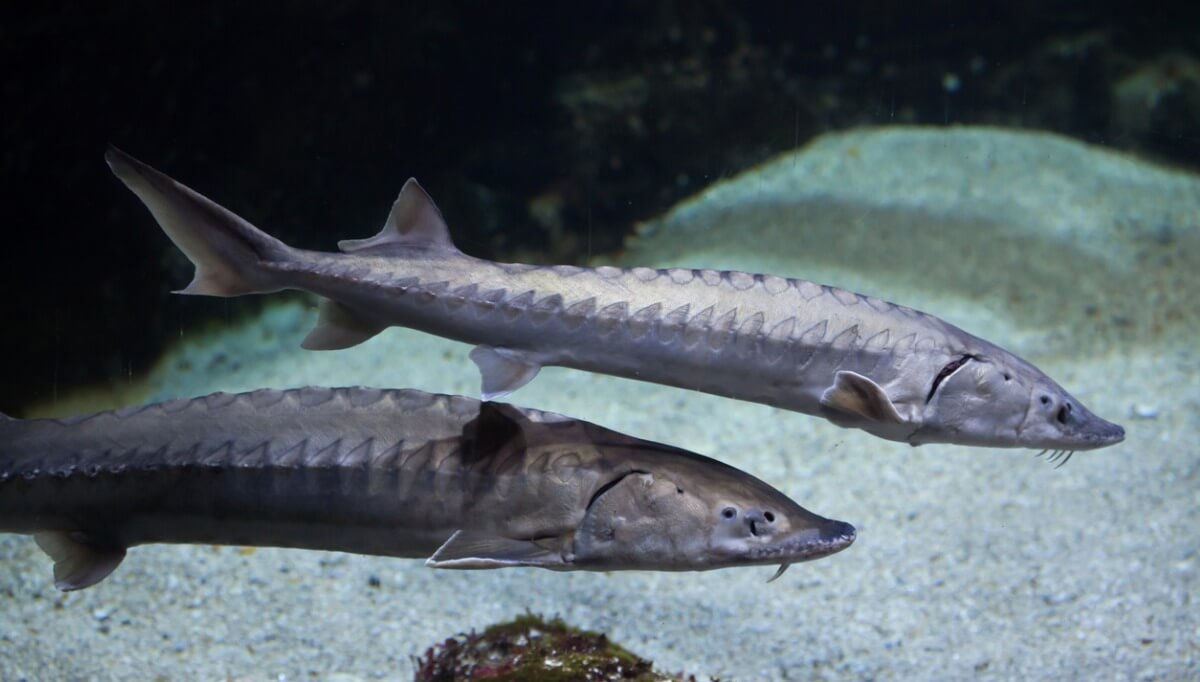Bony Fish: Characteristics and Examples


Written and verified by the biologist Cesar Paul Gonzalez Gonzalez
In nature, the Devonian period was one of the most important moments in history, as in this period most species began to diversify. In addition, it’s also known as the age of fish, because it was then that most of them (both those that still exist and those that are now extinct) coexisted in the same environment. Among these, the group of bony fish, or osteichthyans, was one of the most representative.
This group of fish, along with the agnathans and chondrichthyans, are part of what we simply call fish these days. If you want to learn more about their unique characteristics, read on.
What are bony fish or osteichthyans?
They’re one of the most numerous and complex organisms that exist. Thanks to this, they represent a vast variety of species, and so they’re able to inhabit both inland and marine waters. Their characteristics are distinctive among all fish, of which the following stand out:
- A bony skeleton
- Gill breathing (operculum)
- Skin with scales
- Fins with various shapes and structures
- Gaseous bladder
- A complex jaw
Although, at this point, jawed fish had already appeared, the jaws weren’t too complex. In bony fish, this whole system was improved, creating bones to support the jaw, similar to extensions that were joined to the skull. It was at this time that the premaxillary, maxillary, and dental bones appeared.
This group of fish wasn’t always the most diverse, but took advantage of the decline of the placoderms to become more abundant. According to scientists, this happened 400 million years ago, when they were the kings of the water, but, with the appearance of the mandibulates, they started to have serious problems. As a result, both cartilaginous and bony fishes got a chance to shine.

Swim bladder in bony fishes
In a water environment, one of the biggest challenges that fish face is buoyancy. Because of this, bony fishes developed an organ that resembles a float, as it’s responsible for storing gas inside it to facilitate the organism’s buoyancy. Formally, the swim bladder is part of the embryonic digestive tract that separates and develops into a gas pocket.
This “float” is composed of impermeable walls, making it very difficult for them to lose this gas. However, as the fish increase in depth, this pocket shrinks, due to increased pressure. This causes the fish to have a connection that allows them to control their bladder. This results in two types of fish:
- Physostomes: These control the air in their bladder, by means of a direct duct to the digestive tract, so they simply inhale or exhale air.
- Physoclysters: In this type, there’s no duct, but they have a specialized gland (a gas gland), which, together with several capillaries, control the inflow and outflow of gas.
Not all bony fish have a swim bladder, but it is an advantageous adaptation for the group.
The circulatory system of bony fish
In most fish their circulatory system is simple and closed. The heart pumps blood to the gills, where it’s oxygenated and then returns to the organs. As in humans, a fish’s tubular heart is divided into four chambers:
- Venous sinus: This collects blood without oxygen and directs it to the atrium.
- Atrium: A pouch-shaped muscle that palpitates and directs blood to the ventricle.
- Ventricle: A muscular sac that sucks and pumps.
- Conus arteriosus: A cone that allows the ejection of blood into the gills.
Some lungfish have modifications in their hearts to make oxygenation efficient. This is because they keep the blood that is oxygenated in the gills separate from the blood that is oxygenated in the lungs.
The habitat of bony fish
The variety of species found in this group makes them cosmopolitan, as they can live in salt water (the sea) or fresh water. The latter includes environments with stagnant water, such as lakes, lagoons, or wetlands, to bodies of flowing water, such as rivers. Furthermore, the depth doesn’t matter, because they can inhabit the deep abyssal areas as well as the surface.
What do bony fish eat?
Osteichthyans can feed on a wide variety of food, from plants to live or dead animals. Some may even use a form of filtering, whereby they pick up small invertebrates or particles that serve as food.
In fact, fish have a sense of smell and taste, as they use the openings in their heads to sense particles in the water. Because they don’t use them for breathing, these openings are called nostrils.
The differences between bony and cartilaginous fish
As the name implies, bony fish have a skeleton made of bone, which is a clear difference from cartilaginous fish (chondrichthyans). In fact, in general, the bones are formed from a cartilaginous base, so the only difference is this process of transformation to bone.
In addition, osteichthyans have some structures such as opercula that help them to protect and move water towards the gills. In this way, these organisms don’t have to keep moving in order to breathe; they can move these “fins” and circulate water through their gills. This is completely contrary to chondrichthyans, that need to keep swimming in order to carry out this process.
Classification of bony fish
The characteristics of fish and their shape are coupled to the environment where they live, and their lifestyle. Because aquatic environments vary in their conditions, different ecosystems can be found just a few meters apart. Thanks to this, there’s an enormous diversity of marine species.
For this reason, in order to identify them, a classification has been created that divides bony fish into two large groups, the Actinopterygii and the Sarcopterygii.
Sarcopterygii (Sarcopterygii)
This name derives from“sarkos“, which means meat, and“pterygium” which means fin, alluding to the fleshy fins of the group. They’re characterized by paired fins, a caudal fin with 3 lobes, and cosmoid-like scales. In addition, their gills are supported by bony arches.
The only two representative groups are:
- Dipnoi: These are known as lungfish, with ancestral characteristics, and their distribution covers regions of Africa, Australia, and South America. They have both types of respiration, gills (in water) and pulmonary (in the air).
- Actinistos: These are also called coelacanthids (Coelacanthimorpha) and were once considered extinct. However, some specimens do still exist. They’re called living fossils, because they retain several primitive characteristics. In addition, they have sufficiently wide fins that move in an intercalated manner and resemble “legs”.
Actinopterygians (Actinopterygii)
These receive their name due to the structure of their fins, and the bones that support them (rays). “Aktinos” means ray, and “pterygium” means fin. They’re the most successful group of fish, occupying almost any body of water, such as seas, rivers and lakes.
They usually have skin with numerous glands and a great variety of dermal scales (ganoid, ctenoid and cycloid). Their jaws are usually more developed than in sarcopterygians, so they have better mobility. In addition, they’re considered poikilothermic organisms, which means that they don’t regulate their temperature, and depend on the temperature of their surroundings.
Some groups that are part of the actinopterygians are:
- Neopterygii: These generally live in the fresh waters of North and Central America, comprising two orders with ancestral characteristics, the Lepisosteiformes (Lepisosteiformes) and Amiformes (Ammidae). They have a symmetrical tail and fusiform shape, however, the group contains a great variety of shapes and characteristics.
- Cladistia: This group comprises species with an elongated shape (Anguilliformes), such as the bichirs that inhabit fresh waters in Africa. Their appearance seems primitive and some species have sacs that they use for breathing, which are similar to lungs.
- Chondrichthyes: These are species that still maintain a part of their cartilaginous skeleton. They have a protrusible mouth. It includes species such as sturgeons and paddlefish, which are distributed in temperate or cold waters throughout the northern hemisphere.

Although we have discovered vast numbers of fish species, there are still many more to be discovered. Even so, these beings amaze us with their colors, sizes, and shapes. Nature offers us an incredible spectacle, and it’s up to each one of us to decide whether we going to look after them or not.
All cited sources were thoroughly reviewed by our team to ensure their quality, reliability, currency, and validity. The bibliography of this article was considered reliable and of academic or scientific accuracy.
- Lechleuthner, A., Schumacher, U., Negele, R. D., & Welsch, U. (1989). Lungs of Polypterus and Erpetoichthys. Journal of morphology, 201(2), 161-178.
- Rebollo, D. L. (2020). Organización neuroanatómica de los sistemas catecolaminérgicos, serotoninérgicos, nitrérgicos y orexinérgicos en el sistema nervioso central de los peces holósteos (Doctoral dissertation, Universidad Complutense de Madrid).
- Pérez, H. E. (2014). Biodiversidad de peces en México. Revista Mexicana de Biodiversidad, 85, 35.
- Pough, F. H., Janis, C. M., & Heiser, J. B. (1999). Vertebrate life (No. QL 605. P68 1999). Upper Saddle River, NJ: Prentice Hall.
- Friedman, M., & Brazeau, M. D. (2010). A reappraisal of the origin and basal radiation of the Osteichthyes. Journal of Vertebrate Paleontology, 30(1), 36-56.
- Rebollo, D. L. (2020). Organización neuroanatómica de los sistemas catecolaminérgicos, serotoninérgicos, nitrérgicos y orexinérgicos en el sistema nervioso central de los peces holósteos (Doctoral dissertation, Universidad Complutense de Madrid).
- Sallan, L. C. (2014). Major issues in the origins of ray‐finned fish (A ctinopterygii) biodiversity. Biological Reviews, 89(4), 950-971.
This text is provided for informational purposes only and does not replace consultation with a professional. If in doubt, consult your specialist.